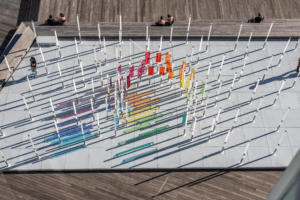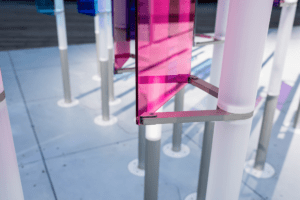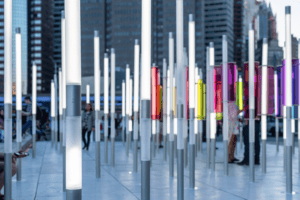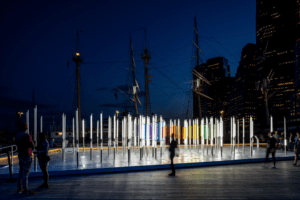Analysis of the Nautilus Light Installation




More at: https://www.theatlantic.com/sponsored/nautilus/lincoln-nautilus/3076/
The Four Goals of Stage Lighting in Nautilus:
- Selective Visibility: Nautilus directs the audience’s attention through its interactive poles. By activating specific poles, participants can influence where and how the light and sound symphony unfolds, thereby focusing the experience on their interaction rather than the whole installation. However, spectators observing from the outside will experience a completely different scene.
- Mood: The installation creates a dynamic mood that shifts with participant interaction. The gentle glow from the poles and the accompanying melodies produce an ambiance of wonder and communal engagement. The mood shifts from serene to vibrant as more participants interact, embodying the natural light’s interaction with the installation. This mood transformation underscores the lighting’s role in evoking specific emotional states.
- Composition: Nautilus uses lighting to organize spaces within the installation, separating the interactive field of poles from the central viewing area. This composition invites participants to engage with the installation from within or to observe from a distance, creating a layered experience that blends the pier’s edge with the surrounding environment. The lighting design supports and enhances the installation’s spatial dynamics, emphasizing the division between the exterior and the interior.
- Revelation of Form: Through its interactive lighting, Nautilus reveals the form of each pole and the collective installation. The lighting responds to touch by illuminating and creating shadows, which add dynamics to the experience. This interplay of light and shadow sculpts the installation, allowing it to emerge as a multi-interacting object that participants can explore and shape.
The Four Properties of Stage Lighting in Nautilus:
- Color: The Nautilus features a spectrum of colors that respond to the tones generated by participant interaction. These colors reflect off the acrylic panels and illuminate the poles, enriching the visual and audio experiences.
- Intensity: The intensity of the lights within Nautilus varies with the strength of interaction, providing a visual feedback loop that encourages continued engagement. Moreover, it also depends on the weather and the gift of natural light.
- Form: The strategic placement of the 95 interactive poles and the central viewing area dictates the installation’s form. The angles at which the lights are placed within each pole affect how participants perceive the installation, from the pulsing lights that emanate with each touch to the overall illumination of the space. This arrangement invites interaction, guiding participants through it.
- Movement: The Nautilus embodies movement in its changing light and sound responses to human touch. This movement is not just physical but temporal, as the installation evolves with the day and the changing natural light. The ability of the installation to sequence interactions over time, creating a layered chorus of light and sound, highlights the dynamic nature of movement within the installation.